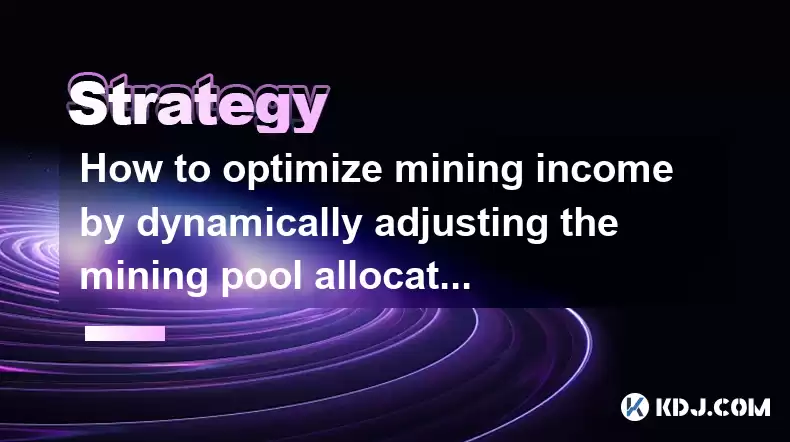-
 Bitcoin
Bitcoin $116500
-0.78% -
 Ethereum
Ethereum $4054
5.10% -
 XRP
XRP $3.297
6.97% -
 Tether USDt
Tether USDt $1.000
-0.04% -
 BNB
BNB $794.1
1.87% -
 Solana
Solana $177.9
3.88% -
 USDC
USDC $0.9998
-0.03% -
 Dogecoin
Dogecoin $0.2280
5.23% -
 TRON
TRON $0.3388
-0.58% -
 Cardano
Cardano $0.7953
4.17% -
 Stellar
Stellar $0.4536
10.14% -
 Hyperliquid
Hyperliquid $40.76
2.57% -
 Sui
Sui $3.846
3.20% -
 Chainlink
Chainlink $19.61
7.61% -
 Bitcoin Cash
Bitcoin Cash $587.7
1.42% -
 Hedera
Hedera $0.2620
3.58% -
 Avalanche
Avalanche $23.73
4.07% -
 Ethena USDe
Ethena USDe $1.001
-0.02% -
 Litecoin
Litecoin $125.6
3.33% -
 Toncoin
Toncoin $3.351
0.96% -
 UNUS SED LEO
UNUS SED LEO $8.983
0.22% -
 Shiba Inu
Shiba Inu $0.00001323
4.71% -
 Uniswap
Uniswap $11.02
7.71% -
 Polkadot
Polkadot $3.973
5.23% -
 Dai
Dai $1.000
-0.02% -
 Bitget Token
Bitget Token $4.498
1.56% -
 Monero
Monero $272.5
5.72% -
 Pepe
Pepe $0.00001191
9.16% -
 Cronos
Cronos $0.1545
3.62% -
 Aave
Aave $293.0
4.90%
如何通過動態調整採礦庫分配策略來優化採礦收入?
基於哈希特,費用和網絡難度,動態調整採礦池分配,通過降低風險並利用各種池的實時利潤率變化來最大化加密貨幣採礦收入。
2025/03/02 11:13

如何通過動態調整採礦庫分配策略來優化採礦收入?
要點:
- 了解影響採礦池盈利能力的因素:哈希,蓋帽,池費,運氣和網絡困難。
- 分析不同的採礦池特徵:池大小,支付方法,服務器位置和透明度。
- 實施動態分配策略:利用實時數據和算法根據觀察到的盈利能力在池之間移動哈希功率。
- 監視和調整:根據不斷變化的市場條件,不斷跟踪性能指標並完善策略。
- 降低風險:多樣化以最大程度地減少特定於池特異性問題的影響。
通過動態池分配優化採礦收入
採礦加密貨幣,尤其是比特幣等工作證明(POW)硬幣,涉及與其他礦工的連續競賽。目的是首先解決複雜的加密難題,並獲得塊獎勵和相關的交易費用。儘管單個採礦盈利能力取決於許多因素,但選擇和戰略性管理您的採礦庫分配至關重要。從長遠來看,您將所有哈希功率都投入到一個池的靜態方法可能會冒險且盈利較低。動態調整採礦池的分配使您能夠利用機會並減輕潛在的損失。
- 了解影響採礦池獲利能力的因素:
確定採礦池的盈利能力的幾個關鍵因素相互作用。忽略這些中的任何一個都可能導致次優回報。
* **Hashrate:** The total computational power (measured in hashes per second) contributed by all miners in a pool significantly impacts the frequency of block finds. A larger hashrate generally leads to more frequent rewards, but also increases the competition for those rewards within the pool. Understanding the pool's hashrate relative to the network's total hashrate is essential. A pool with a significantly smaller share might offer a more stable, albeit smaller, income stream compared to a larger pool with higher variance in block rewards. This variance is caused by the inherent randomness in the PoW algorithm. A smaller share can mean fewer blocks found in a given time, leading to less frequent payouts, while a large share can be risky due to higher competition. * **Block Rewards:** The cryptocurrency's protocol defines the block reward – the primary source of income for miners. These rewards can be fixed (like Bitcoin's halving mechanism) or variable, depending on the coin's design. Understanding the current block reward and its projected future trajectory is critical in evaluating a pool's long-term profitability. Changes in block rewards directly impact the potential income from mining, requiring a reassessment of the pool allocation strategy. Moreover, some coins have different block rewards based on the difficulty, making pool selection even more complex. * **Pool Fees:** Mining pools charge fees for their services, typically a percentage of the mined blocks' rewards. These fees can vary significantly across different pools. Lower fees directly translate to higher net income for miners. A thorough comparison of fees across various pools is a crucial step in selecting profitable options. It's important to understand the fee structure – whether it's a fixed percentage or a tiered system – to accurately predict your earnings. Hidden fees or unexpected charges should be carefully investigated before committing hashpower. * **Luck:** Despite sophisticated calculations, mining inherently involves an element of chance. The time it takes a pool to find a block can vary, leading to periods of higher and lower-than-expected income. This "luck" factor can significantly impact short-term profitability. A pool might be experiencing a lucky streak, yielding higher-than-average rewards temporarily, while another might be experiencing a dry spell. A dynamic strategy helps mitigate the risk associated with this randomness by diversifying across multiple pools. * **Network Difficulty:** The network difficulty, adjusted periodically to maintain a consistent block generation time, directly affects the probability of finding a block. A higher difficulty means it takes more computational power to solve the puzzle, making mining less profitable. Monitoring the network difficulty and its impact on individual pool profitability is crucial for making informed decisions about hashpower allocation. A sudden increase in network difficulty necessitates a reassessment of your mining strategy, possibly requiring a shift to a more efficient pool or a temporary reduction in mining activity.- 分析不同的採礦池特徵:
選擇合適的池涉及了解其特徵,而不僅僅是其報告的盈利能力。
* **Pool Size:** The size of the pool (measured by its total hashrate) influences the frequency of payouts. Larger pools generally offer more frequent payouts due to their higher probability of finding blocks. However, larger pools also mean higher competition for rewards, potentially leading to smaller individual payouts per block found. Smaller pools offer more consistent payouts but with less frequent rewards. The optimal pool size depends on your risk tolerance and mining hardware capacity. * **Payout Methods:** Different pools offer various payout methods, including Pay Per Share (PPS), Pay Per Last N Shares (PPLNS), and Proportional. Each method has its advantages and disadvantages regarding risk and payout frequency. PPS offers consistent payouts regardless of block finds, while PPLNS involves some risk as payouts depend on the number of shares submitted before a block is found. Proportional payouts distribute rewards based on the contribution of each miner. Choosing the right method depends on your risk appetite and long-term mining goals. * **Server Location:** The geographical location of a pool's servers can impact latency and network connectivity. Choosing a pool with servers closer to your location can reduce latency and improve mining efficiency. Network connectivity is crucial for consistent mining performance; a geographically distant pool might experience higher latency, reducing your mining efficiency and potential income. * **Transparency:** A reputable pool should provide transparent information about its operations, including its hashrate, fees, and payout history. Transparency is essential to ensure the pool's legitimacy and trustworthiness. Transparency allows for better monitoring of the pool's performance and helps you make informed decisions about your allocation strategy. Opaque operations can indicate potential risks, such as manipulation of payouts or hidden fees.- 實施動態分配策略:
動態分配策略涉及使用實時數據和算法根據觀察到的盈利能力在池之間移動障礙。這需要持續的監視和調整。
* **Real-time Monitoring Tools:** Several tools and platforms provide real-time data on mining pool performance, including hashrate, fees, and recent block finds. These tools enable you to track the profitability of different pools and adjust your allocation accordingly. Automated systems can even dynamically shift hashpower based on predefined criteria and algorithms. Accurate data is essential for informed decision-making, and unreliable data sources can lead to suboptimal allocation strategies. * **Algorithmic Allocation:** Sophisticated algorithms can analyze real-time data and automatically adjust your hashpower distribution across pools to maximize profitability. These algorithms consider factors like pool hashrate, fees, and network difficulty to determine the optimal allocation. This automated approach eliminates the need for manual adjustments, allowing for more efficient and responsive allocation. However, it's important to choose reliable and well-tested algorithms to ensure optimal performance.- 監視和調整:
不斷跟踪關鍵績效指標(KPI)對於完善您的策略至關重要。
* **Tracking Key Metrics:** Regularly monitor your mining income, pool fees, and the overall profitability of your mining operation. Track the performance of each pool individually, comparing their actual profitability against your expectations. Analyzing these metrics helps identify underperforming pools or unexpected changes in market conditions that might require a shift in your allocation strategy. * **Adapting to Market Changes:** The cryptocurrency market is highly dynamic. Network difficulty, block rewards, and even the popularity of specific pools can change rapidly. Your dynamic allocation strategy should be flexible enough to adapt to these changes, ensuring you remain profitable in evolving market conditions. A static approach might become highly inefficient in the face of sudden market fluctuations, while a dynamic strategy can quickly adjust to maintain optimal profitability.- 降低風險:
多元化是減輕與特定於池特定問題相關的風險的關鍵。
* **Diversification:** Distributing your hashpower across multiple pools reduces your dependence on any single pool's performance. This minimizes the impact of potential issues such as pool outages, unexpected fee increases, or changes in pool management. Diversification doesn't eliminate risk entirely, but it significantly reduces the potential for significant losses. The optimal level of diversification depends on your risk tolerance and the number of reliable pools available.常見問題解答:
問:動態調整採礦池分配有哪些風險?
答:主要風險包括管理多個池的複雜性,切換池的潛在延遲(導致過渡期間的哈希功率損失)以及對準確的實時數據和算法的依賴。設計不佳的算法或數據不正確的數據可能導致次優的分配和降低的盈利能力。網絡問題還可以中斷動態調整過程。
問:我應該多久調整一次採礦池分配?
答:調整的頻率取決於市場波動和您選擇的策略。一些礦工每天進行調整,而另一些礦工可能會調整每週甚至更少的頻率。通常建議在高市場波動期或特定採礦池中發生重大變化時進行更頻繁的調整。
問:是否有任何自動化工具可以幫助動態池分配?
答:是的,幾種軟件應用程序和服務提供了基於實時數據和預定算法的挖掘池分配的自動化工具。這些工具可以簡化流程並可能優化盈利能力。但是,研究和選擇知名工具以避免潛在的騙局或惡意軟件至關重要。
問:動態分配的最佳採礦池是什麼?
答:沒有單個“最佳”池用於動態分配。最佳選擇取決於您採礦的加密貨幣,橋樑,風險承受能力以及每個池提供的功能等因素。在為您的動態分配策略選擇池之前,研究和比較至關重要。考慮池尺寸,費用,支付方法,服務器位置和透明性等因素。
問:動態池分配適合所有礦工?
答:動態池分配對具有較大哈希功率的礦工以及願意花費時間和精力來監視和調整其戰略的礦工特別有益。對於較小的礦工來說,所需的努力可能會超過潛在的好處。但是,即使是小型礦工也可以從精心選擇的池中受益,並了解影響盈利能力的因素。
免責聲明:info@kdj.com
所提供的資訊並非交易建議。 kDJ.com對任何基於本文提供的資訊進行的投資不承擔任何責任。加密貨幣波動性較大,建議您充分研究後謹慎投資!
如果您認為本網站使用的內容侵犯了您的版權,請立即聯絡我們(info@kdj.com),我們將及時刪除。
- 羅馬風暴,資金努力和迫在眉睫的防禦回溯:龍捲風現金案的紐約分鐘
- 2025-08-09 02:50:14
- 加密的狂野騎行:XRP,Dogecoin和Altcoin激增,您不能忽略
- 2025-08-09 02:50:14
- 埃隆·馬斯克(Elon Musk),比特幣和持久的認可力量:加密愛情故事?
- 2025-08-09 03:50:15
- Ruvi AI:在CoinMarketCap上的Rupple之後的下一件大事?
- 2025-08-09 03:50:15
- Floki Price激報:Elliott Wave和Fibonacci設置指向潛在的收益!
- 2025-08-09 02:30:16
- Pepe Price,RTX(REMITTIX?)和$ 10K ETH DREAM:NYC Crypto Chatter
- 2025-08-09 02:30:16
相關知識

如何使用停止損失命令來限制潛在損失?
2025-08-08 14:01:38
了解加密貨幣交易中的停止損失訂單停止訂單是交易者使用的風險管理工具,用於當其價格達到預定水平時自動出售加密貨幣。這種機制有助於限制在加密貨幣空間中常見的揮發性市場的潛在損失。當商人購買數字資產時,他們可能會將停止損失的價格設定為低於當前市場價值。如果價格下降到該水平,則交易所會執行市場或限制賣出訂單...

如何讀取加密貨幣圖表並使用技術分析?
2025-08-08 11:08:17
了解加密貨幣圖表的基礎知識加密貨幣圖是隨著時間的推移價格移動的圖形表示。這些圖表是依靠技術分析做出明智決定的交易者的重要工具。加密貨幣交易中使用的最常見的圖表類型是線圖,燭台圖表和條形圖。其中,燭台圖是由於其豐富的視覺信息而廣泛使用的。每個燭台代表一個特定的時間段,並顯示四個關鍵數據點:開頭價格,收...

在投資加密項目之前,如何進行自己的研究(DYOR)?
2025-08-08 21:07:52
了解加密貨幣中染料的核心原理在投資任何加密貨幣項目之前,進行盡職調查對於減輕風險並做出明智的決定至關重要。代表“做自己的研究”的首字母縮略詞染料是加密社區中的基本原則。它在評估數字資產時強調個人責任。僅依靠社交媒體炒作,有影響力的意見或價格推測會導致重大財務損失。區塊鏈技術的分散性質意味著通常沒有中...

如何避免常見的加密投資錯誤?
2025-07-13 01:35:44
了解加密投資的風險對加密貨幣進行投資可能是高度回報的,但它也帶來很大的風險。投資者犯的最常見的錯誤之一是不完全了解加密貨幣背後的技術和市場動態。與諸如股票或債券之類的傳統資產不同,數字貨幣使用區塊鏈技術在分散網絡上運行。如果沒有基本了解這些系統的運作方式,投資者可能會根據炒作而不是基本面做出不知情的...

什麼是漫長的加密策略?
2025-07-15 10:56:42
了解長短加密策略的基礎知識長短的加密策略是一種投資方法,交易者同時在不同的加密貨幣中佔據了長期職位,以利用市場效率低下。這種方法使投資者可以從上漲和下跌的價格中獲利,從而使其在加密貨幣等動盪市場中特別有價值。在這種情況下,較長的位置意味著購買加密貨幣,期望其價格會隨著時間而上漲。相反,一個較短的頭寸...

什麼是漫長的加密策略?
2025-07-11 13:28:38
了解Long-Short加密策略的基礎知識長短的加密策略是一種投資方法,交易者在加密貨幣市場中佔據了長期和短職位,以從價格變動中獲利。在此策略中,交易者購買(長期)預計價值會增加的資產,同時出售(短路)資產預計會下降。目標是對沖市場波動,而不管整個市場的上升還是下降,都會產生回報。這種方法在高度波動...

如何使用停止損失命令來限制潛在損失?
2025-08-08 14:01:38
了解加密貨幣交易中的停止損失訂單停止訂單是交易者使用的風險管理工具,用於當其價格達到預定水平時自動出售加密貨幣。這種機制有助於限制在加密貨幣空間中常見的揮發性市場的潛在損失。當商人購買數字資產時,他們可能會將停止損失的價格設定為低於當前市場價值。如果價格下降到該水平,則交易所會執行市場或限制賣出訂單...

如何讀取加密貨幣圖表並使用技術分析?
2025-08-08 11:08:17
了解加密貨幣圖表的基礎知識加密貨幣圖是隨著時間的推移價格移動的圖形表示。這些圖表是依靠技術分析做出明智決定的交易者的重要工具。加密貨幣交易中使用的最常見的圖表類型是線圖,燭台圖表和條形圖。其中,燭台圖是由於其豐富的視覺信息而廣泛使用的。每個燭台代表一個特定的時間段,並顯示四個關鍵數據點:開頭價格,收...

在投資加密項目之前,如何進行自己的研究(DYOR)?
2025-08-08 21:07:52
了解加密貨幣中染料的核心原理在投資任何加密貨幣項目之前,進行盡職調查對於減輕風險並做出明智的決定至關重要。代表“做自己的研究”的首字母縮略詞染料是加密社區中的基本原則。它在評估數字資產時強調個人責任。僅依靠社交媒體炒作,有影響力的意見或價格推測會導致重大財務損失。區塊鏈技術的分散性質意味著通常沒有中...

如何避免常見的加密投資錯誤?
2025-07-13 01:35:44
了解加密投資的風險對加密貨幣進行投資可能是高度回報的,但它也帶來很大的風險。投資者犯的最常見的錯誤之一是不完全了解加密貨幣背後的技術和市場動態。與諸如股票或債券之類的傳統資產不同,數字貨幣使用區塊鏈技術在分散網絡上運行。如果沒有基本了解這些系統的運作方式,投資者可能會根據炒作而不是基本面做出不知情的...

什麼是漫長的加密策略?
2025-07-15 10:56:42
了解長短加密策略的基礎知識長短的加密策略是一種投資方法,交易者同時在不同的加密貨幣中佔據了長期職位,以利用市場效率低下。這種方法使投資者可以從上漲和下跌的價格中獲利,從而使其在加密貨幣等動盪市場中特別有價值。在這種情況下,較長的位置意味著購買加密貨幣,期望其價格會隨著時間而上漲。相反,一個較短的頭寸...

什麼是漫長的加密策略?
2025-07-11 13:28:38
了解Long-Short加密策略的基礎知識長短的加密策略是一種投資方法,交易者在加密貨幣市場中佔據了長期和短職位,以從價格變動中獲利。在此策略中,交易者購買(長期)預計價值會增加的資產,同時出售(短路)資產預計會下降。目標是對沖市場波動,而不管整個市場的上升還是下降,都會產生回報。這種方法在高度波動...
看所有文章

























































































